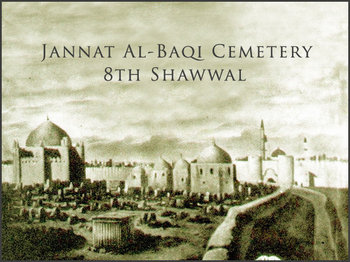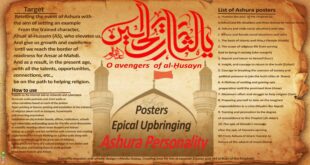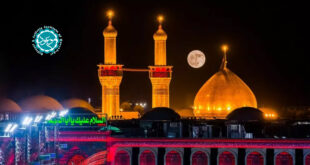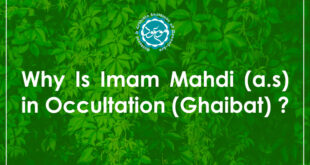The First Destruction of Al-Baqi
The Wahhabis believed that visiting the graves and the shrines of the Prophets, the Imams, or the saints was a form of idolatry and totally un-Islamic. Those who did not conform with their belief were killed and their property was confiscated. Since their first invasion of Iraq, and till nowadays, in fact, the Wahhabis, as well as other rulers of the Gulf States, having been carrying out massacres from which no Muslim who disagreed with them was spared. Obviously, the rest of the Islamic World viewed those graves with deep reverence. Had it not been so, the two caliphs Abu Bakr and Umar would not have expressed their desire for burial near the grave of the Prophet (s).
From 1205 AH to 1217 AH, the Wahhabis made several attempts to gain a foothold in Hijaz but failed. Finally, in 1217 AH, they somehow emerged victorious in Taif where they spilled the innocent blood of Muslims. In 1218 AH, they entered Makkah and destroyed all sacred places and domes there, including the one which served as a canopy over the well of Zamzam.
In 1221, the Wahhabis entered Madina to desecrate al-Baqi as well as every mosque they came across. An attempt was even made to demolish the Prophet`s tomb, but for one reason or another, the idea was abandoned. In subsequent years, Muslims from Iraq, Syria, and Egypt were refused entry into Makkah for Hajj. King Al-Saud set a precondition that those who wished to perform the pilgrimage would have to accept Wahhabism or else be branded as non-Muslims, becoming ineligible for entry into the Haram.
Al-Baqi was razed to the ground, with no sign of any grave or tomb whatsoever. But the Saudis were still not quite satisfied with doing all of that. Their king ordered three black attendants at the Prophet`s shrine to show him where the treasure of valuable gifts were stored. The Wahhabis plundered the treasure for their own use.
Thousands of Muslims fled Makkah and Madina in a bid to save their lives and escape from the mounting pressure and persecution at the hands of the Wahhabis. Muslims from all over the world denounced this Saudi savagery and exhorted the Caliphate of the Ottoman Empire to save the sacred shrines from total destruction.
Then, as it is known, Muhammad Ali Basha attacked Hijaz and, with the support of local tribes, managed to restore law and order in Madina and Makkah, dislodging the Al-Saud clansmen. The entire Muslim world celebrated this victory with great fanfare and rejoicing. In Cairo, the celebrations continued for five days. No doubt, the joy was due to the fact that pilgrims were once more allowed freely to go for Hajj, and the sacred shrines were once again restored.
In 1818 AD, the Ottaman Caliph Abdul Majid and his successors, Caliphs Abdul Hamid and Mohammed, carried out the reconstruction of all sacred places, restoring the Islamic heritage at all important sites. In 1848 and 1860 AD, further renovations were made at the expense of nearly seven hundred thousand pounds, most of which came from the donations collected at the Prophet`s tomb.
The second plunder by the Wahhabis
The Ottoman Empire had added to the splendor of Madina and Makkah by building religious structures of great beauty and architectural value. Richard Burton, who visited the holy shrines in 1853 AD disguised as an Afghan Muslim and adopting the Muslim name Abdullah, speaks of Madina boasting 55 mosques and holy shrines. Another English adventurer who visited Madina in 1877-1878 AD describes it as a small beautiful city resembling Istanbul. He writes about its white walls, golden slender minarets and green fields.
1924 AD Wahhabis entered Hijaz for a second time and carried out another merciless plunder and massacre. People in streets were killed. Houses were razed to the ground. Women and children too were not spared.
Awn bin Hashim (Shairf of Makkah) writes: “Before me, a valley appeared to have been paved with corpses, dried blood staining everywhere all around. There was hardly a tree which didn`t have one or two dead bodies near its roots.”
1925 Madina surrendered to the Wahhabi onslaught. All Islamic heritage were destroyed. The only shrine that remained intact was that of the Holy Prophet (s).
Ibn Jabhan says: “We know that the tomb standing on the Prophet`s grave is against our principles, and to have his grave in a mosque is an abominable sin.”
Tombs of Hamza and other martyrs were demolished at Uhud. The Prophet`s mosque was bombarded. On protest by Muslims, assurances were given by Ibn Saud that it will be restored but the promise was never fulfilled. A promise was given that Hijaz will have an Islamic multinational government. This was also abandoned.
1925 AD Jannat Al-Mu`alla, the sacred cemetery at Makkah was destroyed along with the house where the Holy Prophet (s) was born. Since then, this day is a day of mourning for all Muslims.
Is it not strange that the Wahhabis find it offensive to have the tombs, shrines and other places of importance preserved, while the remains of their Saudi kings are being guarded at the expense of millions of dollars?
Protest from Indian Muslims
1926, protest gatherings were held by shocked Muslims all over the world. Resolutions were passed and a statement outlining the crimes perpetrated by Wahhabis was issued and included the following:
1. The destruction and desecration of the holy places i.e. the birth place of the Holy Prophet [s], the graves of Banu Hashim in Makkah and in Jannat al-Baqi (Madinah), the refusal of the Wahhabis to allow Muslims to recite Ziyarah or Surah Al-Fatiha at those graves.
2. The destruction of the places of worship i.e. Masjid Hamza, Masjid Abu Rasheed, in addition to the tombs of Imams and Sahaba (Prophet`s companions).
3. Interference in the performance of Hajj rituals.
4. Forcing the Muslims to follow the Wahhabis innovations and to abandon their own ways according to the guidance of the Imams they follow.
5. The massacre of Sayyids in Taif, Madina, Ahsa, and Qatif.
6. The demolition of the grave of the Imams at al-Baqi which deeply offended and grieved all Shias.
Protest from other countries
Similar protests were lodged by Muslims in Iran, Iraq, Egypt, Indonesia, and Turkey. All of them condemn the Saudi Wahhabis for their barbaric acts. Some scholars wrote tracts and books to tell the world the fact that what was happening in Hijaz was actually a conspiracy plotted by the Jews against Islam, under the guise of Tawheed. The idea was to eradicate the Islamic legacy and heritage and to systematically remove all its vestiges so that in the days to come, Muslims will have no affiliation with their religious history.
A partial list of the demolished graves and shrines
· Al-Mualla graveyard in Makkah which includes the grave of Sayyida Khadija bint Khuwailid (a), wife of the Prophet (s), the grave of Amina bint Wahab, mother of the Prophet (s), the grave of Abu Talib, father of Imam Ali (a), and the grave of Abdul Muttalib, grandfather of the Prophet (s)
· The grave of Hawa (Eve) in Jeddah
· The grave of the father of the Prophet (s) in Madina
· The house of sorrows (Bayt Al-Ahzan) of Sayyida Fatima (a) in Madina
· The Salman al-Farsi mosque in Madina
· The Raj`at ash-Shams mosque in Madina
· The house of the Prophet (s) in Madina, where he lived after migrating from Makkah
· The house of Imam Ja`far Al-Sadiq (a) in Madina
· The complex (mahhalla) of Banu Hashim in Madina
· The house of Imam Ali (a) where Imam Hasan (a) and Imam Husayn (a) were born
· The house of Hamza and the graves of the martyrs of Uhud (a)
 Mouood Mouood English Edition
Mouood Mouood English Edition




